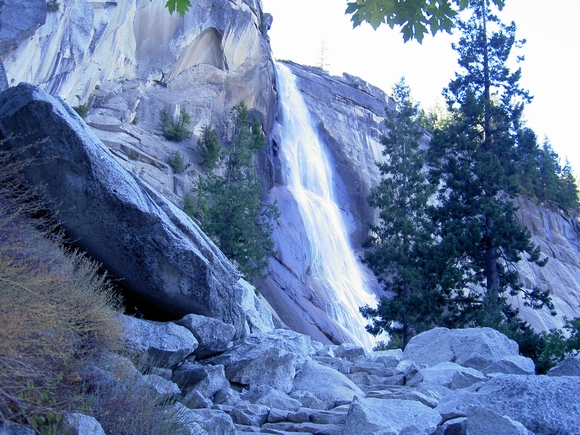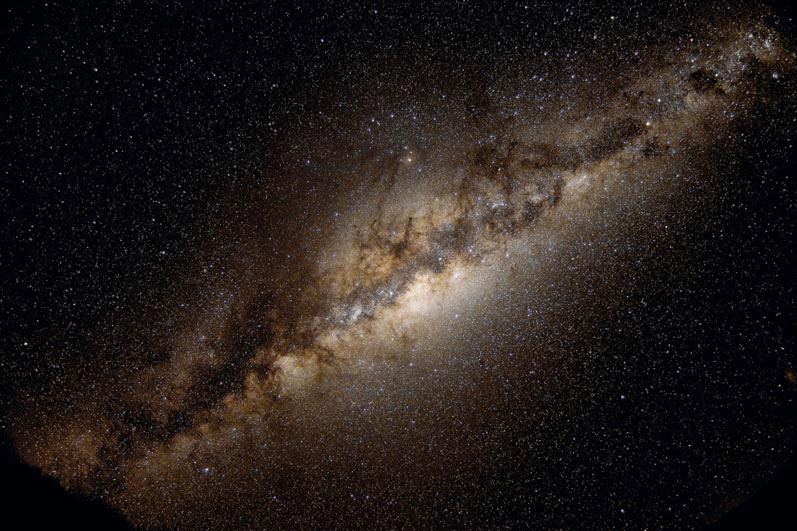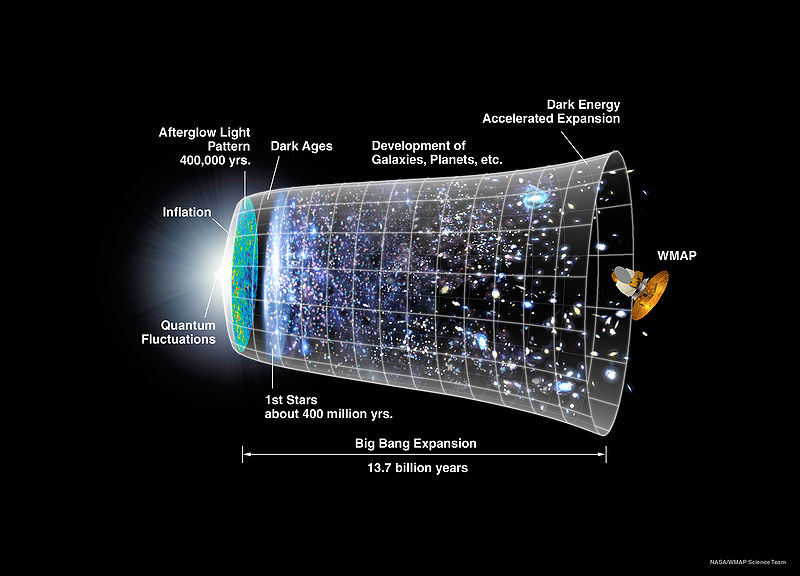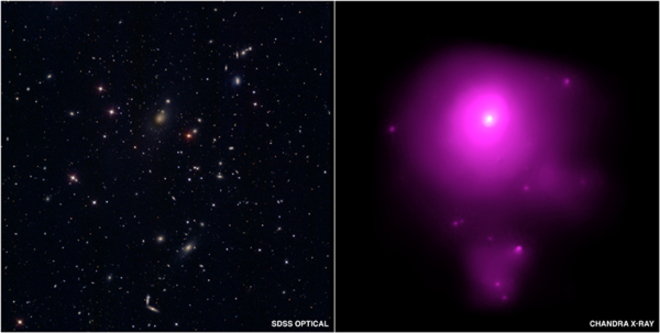I just completed my annual trek through the Sierras. This year I was out for two weeks, backpacking, most of it above 9,000 feet. During the day I experience the majesty of 4,000 meter granite peaks formed from plumes of magma deep within the shifting plates of North America and the Pacific.

At night beneath crystalline skies, the Milky Way is strewn across the heavens with its array of constellations and multiform stars. This year's trip coincided with the Perseids — a spectacular meteor shower of cometary debris. Much of Earth's water may have been delivered by asteroid or cometary impacts eons ago.
Not surprisingly in such environs, my thoughts always turn to the big questions.
How did we come to exist? Why, in fact, does anything exist? Could the Universe have turned out in some other way? Are there, in fact, other Universes? Is progress inevitable in the Universe? Does intelligent life exist anywhere besides Earth?
Although I was hiking solo this year, I was astounded by the number of fellow seekers on the trail: physicists, theologians, environmentalists, neuroscientists, engineers, and philosophers. We would chat, sometimes for days, and the possibility of fine-tuning of the Universe frequently arises (from scientists as well as religious folk.)
(Here's an invitation for you — come to Vogelsang in August. I frequently lecture there under the stars to a few dozen hikers. If the seven mile backpack in is too much, you can hire Sheridan King (just your average 70+ year old Buddhist mule skinner) to bring you in — ask her about mule consciousness. )

La Voie Lactee (the Milky Way) by astrophotographer Serge Brunier
(See Serge's other photos — all mind-bending. He takes these photos in Chile’s Atacama Desert — home of most of the world’s largest telescopes.)
There are perhaps two or three dozen physical constants that characterize the nature of our Universe.
Some of these are 1) the speed of light, 2) the strength of gravity, 3) the strength of electromagnetism, 4) the strength of the strong force that binds protons and neutrons (and quarks) together to form atomic nuclei, 5) the relative masses of electrons and protons, 6) the ratio of strengths of electromagnetism to gravity, and so on.
Many physicists think these physical constants have to be very narrowly constrained to allow for the existence of a Universe that permits life.
Think of a Universe-creating machine with many knobs with God seated at the control panel. If the knobs are not very carefully set, the Universe will be still-born. Atomic nuclei will not form; hydrogen, helium and deuterium will not form; stars will not form; atomic fusion will not occur; galaxies will not form, the supernovas that created the ninety two natural elements will not occur; planets will not form; and life will not happen.
Some of these physical constants appear to be so finely-tuned that infinitesimal deviations might've caused collapse. Needless to say, this state of affairs adds fire to the long-standing debates among theologians, physicists, and biologists about the nature of creation.
I've heard dozens of lectures by leading cosmologists on this topic. How did all that exists come to be?
Before I launch into fine-tuning, you need to be generally aware of how the Universe developed from its initial seed in the Big Bang.
That story has been told in a series of wikis (my slang for Wikipedia articles) — the Big Bang, the Universe, and the Timeline of the Big Bang.
The cover story in the September, 2009 issue of Scientific American by physicist Michael Turner also succinctly described the Origin of the Universe.. Here it is, in the proverbial nutshell.

The Big Bang
13.7 billion years ago: Big Bang occurs from an initial dot of infinitely hot, infinitely dense matter — infinite used loosely.
10-35 seconds : Cosmic inflation creates a large smooth patch of space filled with lumpy quark soup.
First microsecond: protons and neutrons form from quarks.
First few minutes: (as early as one .01 seconds) Helium, lithium, deuterium form from protons and neutrons.
380,000 years later : Atoms form from nuclei and electrons. Before this, the Universe was opaque. Since electrons were not bound, all light was immediately scattered — like scuba-diving in cream soup. At this moment, for the first time, the Universe was transparent.
300 million years goes by: the Dark Ages end. Gravity enables the first stars and galaxies to form.
One Billion years: The limit of current astronomical observations (highest redshift objects.)
Three billion years: Clusters of galaxies form; star formation peaks.
Nine billion years: Solar system forms — Earth is 4.5 billion years old.
(minor footnote: life began 3.7 billion years ago)
10 billion years: Dark Energy causes accelerated expansion of Universe.
(I'm skipping over a lot of stuff.)
two million years ago: Homo habilis evolved (our distant ancestors - early species of hominoids)
two hundred thousand years ago : Homo sapiens appears.
ten thousand years ago: agriculture and later, the first cities

Evolution of the Universe
Gathering material for this essay, I was delighted to find an outstanding collection of video interviews by many of the physicists who created the current view of the origins of the Universe.
That website, ClosertoTruth , has interviews of the top-gun physicists on the planet. Robert Kuhn, who conducts the interviews, has selected the cream of the crop: several Nobel laureates, prominent authors, physicists, cosmologists, philosophers and professors of theology. (These are all freely available online thanks to Robert.)As several of the physicists state, there are several possible explanations for fine-tuning. (I will revisit these and others at the conclusion, but this will help you get my drift.)
Religious explanation: God created the Universe (by setting the knobs just so.)
Random luck: It just turned out the way it did. We won the cosmic jackpot.
Grand Theory: An unknown physical state of affairs forces things to be the way they are.
Scientists haven’t worked it out yet. Maybe we're just too primitive to figure it out. Monkeys don’t understand quantum mechanics either.
Multiverse: There are an infinite number of Universes with different laws.
The number 10500 always get bandied about (from string-theoretic possibilities.)
We're in one of the very few that permits life.
I’ll come back to these later.

Let’s examine one important class of knobs on the Universe-creation machine. These knobs are called the coupling constants. These are the constants that determine how strongly a particle feels a particular force.
The best known of these is the fine structure constant, alpha, which determines the strength of the electromagnetic force on an electron. (Here I summarize the wiki on the fine structure constant . )
According to quantum mechanics, negatively charged electrons are confined to their particular orbits around the positively charged nucleus by the exchange of photons only of particular definite energies. These quantized orbitals determine how tightly bound an electron is to the nucleus. This relationship is reflected by the fine structure constant alpha, which = about 1 / 137.
Now, the question is why is it 1 / 137? If it were 4% larger, then stellar fusion would not produce carbon, so carbon-based life would be impossible! If it was as big as 0.1, then stellar fusion itself would be impossible, and there would no stars in the Universe! As Nobel laureate Richard Feynman put it in 1985 —
all good theoretical physicists put this number up on their wall and worry about it. Nobody knows where the number comes from. It's one of the greatest mysteries of physics ... You might say the hand of God wrote that number and we don't know how He pushed his pencil.
Or, consider this quote from Nobel laureate Max Born that appears in Arthur I. Miller's 2009 book, Deciphering the Cosmic Number:
"If alpha [the fine structure constant] were bigger than it really is, we should not be able to distinguish matter from ether [the vacuum, nothingness], and our task to disentangle the natural laws would be hopelessly difficult. The fact however that alpha has just its value 1/137 is certainly no chance but is itself a law of nature. It's clear that the explanation of this number must be the central problem of natural philosophy."
Living organisms are made from about two dozen elements, principally carbon, hydrogen, oxygen, nitrogen, phosphorus, and sulfur, but also many other elements including sodium, potassium, chlorine, calcium, magnesium, iron, copper, and zinc. If the coupling constants were substantially different, then only hydrogen would've formed. Therefore, the existence of life utterly depends on a compatible fine structure constant.

Rrecently, because of discoveries just in the past two decades, the cosmological constant, omega lambda, has taken center stage.
The ultimate fate of the Universe had long been an open question. Then, in 1998, observations of distant Type 1a supernovas indicated unexpectedly that the Universe is undergoing an accelerated expansion. This has since been confirmed many times.
Presumably the Universe is expanding as a result of residual effects of the Big Bang, the event 13.7 billion years ago that created all matter from an infinitely dense, infinitely hot dot in the quantum foam.
But due to the gravitational force of all that matter, it was generally thought that the expansion would be slowing down, just like a ball attached to a paddle by a rubber string. However, the Nobel-winning surprise is that the distant supernovas are actually speeding away from us faster and faster. What, in God's name, is driving that acceleration?
The current best theory is Dark Energy! All of space is filled with this type of energy, which, unlike gravity, exerts a repellent force on all matter. That, according to present theory, is what's causing the Universe's accelerating expansion.
The cosmological constant expresses the relationship between this energy density of the vacuum of space and the density of the material universe.
It's important because the calculated value appears to imply that the vacuum of space has a positive value that is driving that acceleration. Dark energy, by the way, appears to constitute 70% of the entire mass-energy of the Universe! Notably, if one tries to derive its value from the standard quantum model of physics, then the resulting theoretical value is off by 120 orders of magnitude. Obviously, something's wrong!
So, the cosmological constant is another of those physical constants whose value is a total mystery, and yet it plays a key role in the fate of the Universe.
So, we're left with a conundrum — how were these dozens of physical constants so finely tuned?

Michelangelo’s Creation of Man from the ceiling of the Sistine Chapel
All we really know for sure is that we're here, and that if suitable conditions had not prevailed for the billions of years that it took for us to evolve, then we would'nt even be here wondering about all this.
This is called the anthropic principle and it has two forms — the weak form and the strong form.
The weak anthropic principle is what I just stated — since we exist, we must find ourselves in circumstancing allowing for our existence. To paraphrase Descartes, cogito ergo mundus talis est. I think, therefore, the world is such as it is. This seems like an obvious truth or tautology, but It's useful, nonetheless. Nobelist Roger Penrose explains this usefulness when he paraphrases Brandon Carter and Robert Dicke "the epoch in which we live coincides with the lifetime of main-sequence stars, such as the sun. During any other epoch, there would be no intelligent life around to measure the physical constants." This line of thinking does seem to account for the fact that we live at a time that's about half way through the life of our sun and that our bodies are at the geometric mean of objects in the Universe.
However, the weak version of the principle doesn't really seem to have enough juice to explain the miracle of existence, namely, why are the physical constants of nature so precisely set?
(Note: I'm not asserting that God is the explanation. But, if you think that existing physical theory has this all figured out, you're wrong. It doesn't! Religious folks, note — this is perhaps the best argument in your kit bag.)
The strong anthropic principle just adds a MUST to the statement.
The Universe MUST have the properties that it has, which allow (intelligent) life to develop. Or, (less grandly) the Universe MUST have the properties that we observe it to have. That's the version of the anthropic principle that generates all the controversy.
So, what's the consensus among the scientists? (And, I'll also include possibilities from the philosophers of science, and from the theologians? (Note: when I say theologians, I'm talking about serious academics, not country parsons.)
Here are some of the possibilities enumerated by physicist Paul Davies. He listed these in his book The Goldilocks Enigma Why is the Universe Just Right for Life? (I introduced Paul a few years ago when he was on a book tour. Below, I've also added my own intuitions — just one man’s opinions.)
1. The absurd universe
Our universe - and it is the only one in existence - just happens to be the way it is. (This possibility strikes me as being highly unlikely.)
2. The unique universe
There is a deep underlying unity in physics which necessitates the universe being the way it is.
Some grand theory will explain why the various features of the Universe must have exactly the values that we see.
Could be — this has some appeal. This also provides the motivation for thousands of papers on grand unification, string theory, and quantum loop theory.
The idea is that these seemingly arbitrary physical constants MUST have their observed values because of some deep underlying structure of nature. Unfortunately, as Martin Rees, the Astronomer Royal, points out in ClosertoTruth, our brains at present may just be too primitive to perceive that deep structure. That discovery may need to await humanity 2.0 .
3. The multiverse
Multiple Universes exist having all possible combinations of characteristics, and we inevitably find ourselves within a Universe that allows us to exist.
When I first heard of the Multiverse theory, championed by Stanford physicist Andre Linde, I was delighted. His theory of chaotic eternal inflation creates multiple universes all the time, not just ours. Some of them contain life like ours and others don't. As several physicists comment on Closertotruth, however, this can be viewed as simply (a cop-out) a failure to find the grand theory (possibility two). We don't understand why or how our set of physical constants turned out to be so precisely set, therefore, we resort to this fallback position.
4. Creationism
A creator designed the Universe with the purpose of supporting complexity and the emergence of Intelligence. If you're religious, this is for you. God created the Universe as we see it. Note, however, that even if you're not religious, there are versions of creationism that still work.
Consider the Biocosm hypothesis of James Gardner . Technological society is developing god-like powers of creation. In the future it may be possible to create black holes and other seemingly miraculous feats of cosmic proportion. It's conceivable that our Big Bang was designed by just such a powerful agent or civilization expressly with the purpose of perpetuating intelligent life.
5. The life principle
There is an underlying principle that constrains the universe to evolve towards life and mind. (This appears to be a subset of the unique universe hypothesis above - fascinating and driving lots of research in origins of life and evolutionary psychology. That intelligence evolved, given living organisms, is easy to explain. It confers a large survival benefit for an individual organism. Whether it also confers longevity on human civilization as a whole is not known. The possiblity of technological annihilation of mankind might explain the Fermi Paradox, the apparent rarity of extraterrestrials. The evolution of consciousness as an accompaniment of intelligence is also unexplained.
Note, however, that natural selection by evolution only helps once you’ve got life. That’s just events on Earth in the past 4 billion years. It says nothing about how we got from a sea of hot quarks 14 billion years ago until the Solar system came into existence 5 billion years ago.
Physicist Lee Smolin offers just such a possibility — cosmological natural selection of fecund universes.
This, like some versions of the Multiverse, is Darwinian selection happening on a cosmic scale. Quoting wiki,
"the theory surmises that a collapsing black hole causes the emergence of a new universe on the other side, whose fundamental constant parameters may differ slightly from those of the universe where the black hole collapsed. Each universe therefore gives rise to as many new universes as it has black holes. Thus the theory contains the evolutionary ideas of reproduction and mutation of universes, but has no direct analogue of natural selection. However, given any universe that can produce black holes that successfully spawn new universes, it is possible that some number of those universes will reach heat death with unsuccessful parameters. So, in a sense, fecundity or cosmological natural selection is one where universes could die off before successfully reproducing, just as any biological being can die without having children. "
So, according to Lee Smolin, black holes may create new Universes, each with slightly different physical laws. Physicist Louis Crane extends the analogy to biological evolution even further with his meduso-anthropic principle. Here's the idea.
Very advanced civilizations may find it advantageous to engineer black holes. (Small black holes may be convenient garbage dumps; they are also efficient, long-lasting generators of energy via Hawking radiation.) Now, notice that this has inserted advanced intelligence and longevity into the Universe generation enterprise. This means that Universes that produce such civilizations may have a higher probability of producing similar offspring.
(My thanks to physicist and AI-researcher Steve Omohundro for bringing the meduso-anthropic principle to my attention. See Steve's essays on the ubiquity of cooperation in the evolution of life. It's not all tooth and claw.)
The meduso-anthropic principle is named for the medusa jellyfish whose two-part life cycle involves not only the mature jellyfish (intelligent civilizations) but also their reproducing polyps (the black holes).

Will we ever find out which of these theories, if any, really describes the Universe?
Although it's easy to dismiss all these theories as idle speculation, I'm tremendously heartened by the progress we've made in the past hundred years. Even during Einstein's time, a hundred years ago, astronomers thought our Universe consisted only of an eternally static Milky Way galaxy.Upon reflection, it's clear that experimental data combined with theory have created spectacular advances in cosmology, as in the recent discovery of the Higgs Boson from the Large Hadron Collider in Geneva. Further development of theory, perhaps combined with new observations from ground-based telescopes, like the proposed Square Kilometer Array, or space-based telescopes, like the incipient James Webb (to be launched in 2018) will help illuminate our place in the Universe.
Raw existence is a miracle. In the first 10-43 seconds the Universe winked into existence.
A dot of mass-energy that was infinitely hot and dense materialized from an infinite sea of quantum foam.
13.7 billion years later here we are, a civilization of 7.5 billion human beings — conscious, intelligent agents whose combined action will determine the fate of all higher life on our planet. (See Sir Martin Rees, Britain's Astronomer Royal, present the Doomsday Argument for the importance of humanity's stewardship or lack thereof. This may be the most important link on my entire website.)
The Universe — from the moment of its inception — has incontrovertibly progressed toward self-organization into entities of increasingly great complexity. Earth is the only planet we know that sustains any forms of life, let alone intelligent life. (But see the exciting exo-planet discoveries coming from the Kepler Mission!)
It took nine billion years for the Universe to create Earth and another five billion years to create our civilization. Now, there is an unacceptably high probability that we may end it within the next few decades.
Whether we're alone or part of a vast collective of civilizations, we do not know. We are now the stewards of our collective fate and the fate of higher life forms on Earth.
Our greatest efforts and wisdom must be devoted to the longevity of our civilization and to sustaining, in perpetuity, all life on Earth.